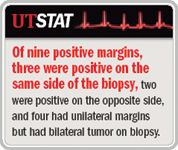Article
TRUS biopsies found not useful for tumor location
Author(s):
Cleveland-Preoperative transrectal ultrasound biopsies are not always reliable tools for predicting positive surgical margins and tumor location in nerve-sparing robotic radical prostatectomies. However, this unreliability may be partly due to the biopsy results coming from outside labs and pathologists versus in-house evaluations.
Cleveland-Preoperative transrectal ultrasound biopsies are not always reliable tools for predicting positive surgical margins and tumor location in nerve-sparing robotic radical prostatectomies. However, this unreliability may be partly due to the biopsy results coming from outside labs and pathologists versus in-house evaluations.

"We focus a lot on the preoperative biopsy to decide whether or not we're going to do nerve-sparing surgery," Dr. Tewari told attendees at the World Congress of Endourology here. "If we're trying to do nerve sparing, are we doing it intrafascially, extrafascially, or [foregoing] nerve-sparing? I was surprised that 30% of the time when I got a positive margin, it was in an area where there was no cancer in the pre-op biopsy."

Out of the 150 patients, 10 had positive surgical margins. One case was excluded because of insufficient data. Of the remaining nine cases, three had the positive surgical margin on the same side as the biopsy showed, two had positive surgical margins on the opposite side from what the biopsy had shown, and four had unilateral surgical margins but had bilateral tumor on the biopsy.

Not good enough
Dr. Tewari did not mince words about the results of the study.
"Either we need to do a better job, or we need to find a method for real-time tissue recognition," he said. "That's the only message out of this: that the biopsies don't translate into how close we can come, or we can do a subpartial dissection, which I don't think is a safe approach."
TRUS biopsy was not accurate enough to be used as a tool for something as precise as optimizing how accurate the surgeon can be regarding nerve-sparing during RAP.
However, the practice of using biopsies from outside labs and assessments from outside pathologists came under scrutiny during discussion of the study. Using the services of outside labs is often less expensive, but the quality may not be the same as that found within the institution performing the procedure.
Newsletter
Stay current with the latest urology news and practice-changing insights — sign up now for the essential updates every urologist needs.















